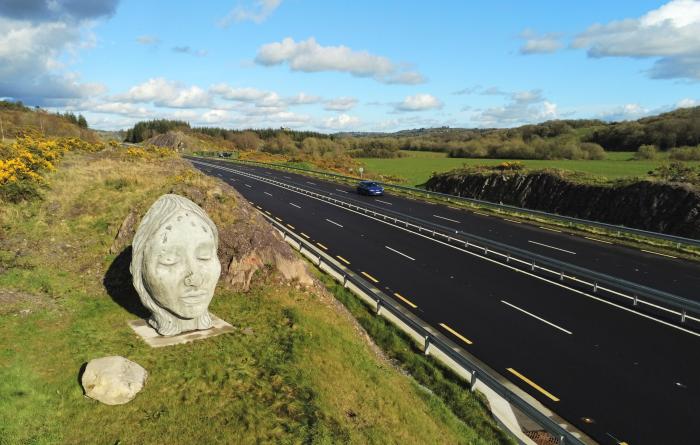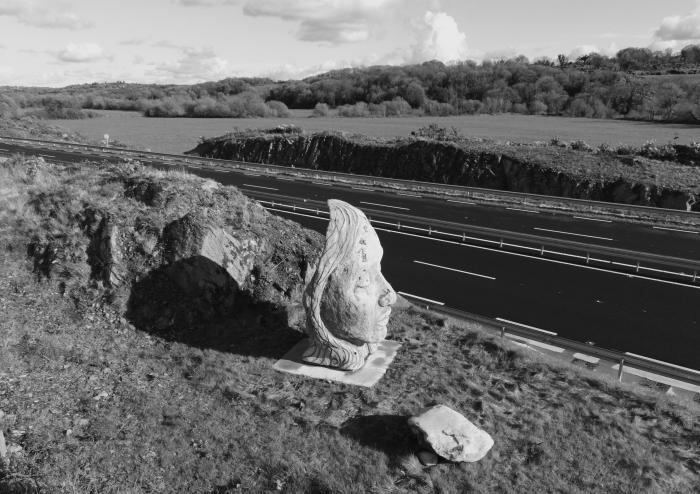Facing the Past: The N22 Per Cent for Art Piece ‘Bronze Age Girl’
By Ed Lyne, Resident Archaeologist with Cork County Council
The recent unveiling of the Per Cent for Art Scheme sculptures on the N22 Baile Bhuirne to Macroom Road Development gained significant interest in the media, both locally in County Cork and, indeed, nationally, even featuring on RTÉ News and on the RTÉ website, as well as on social media platforms. Such interest in commissioned public art pieces is not a given and is testament to the quality of the work of artist Sarah Goyvaerts, and of her inspiration for the pieces which stemmed from local mythology (‘Áine’) and archaeological heritage (‘Bronze Age Girl’) in equal parts. It is perhaps the local nature of the inspiration that is most notable and seems to be striking a chord with the communities in the hinterland of the new road, and further afield. While art appreciation is subjective, the new artworks, commissioned by Cork County Council and Transport Infrastructure Ireland (TII), appear to be almost universally admired since their unveiling.

The ‘Bronze Age Girl’ sculpture on the N22 Baile Bhuirne to Macroom Road Development (all photos by Ronan Spillane, Cork County Council).
The archaeological excavations along the route of the new N22 were carried out by Rubicon Heritage Services Ltd and TVAS Ireland Ltd under the oversight of Deirdre McCarthy (Resident Archaeologist, Cork County Council) and Ken Hanley (Project Archaeologist, TII). The pre-construction archaeological investigations led to the discovery of some 50 sites of both prehistoric and historic date. Many Bronze Age fulachtaí fia or burnt mounds were excavated, along with charcoal production pits, part of a ringfort, some kilns, and a substantial mill site close to the Foherish River. Just one cremation pit was documented, at Kilnagurteen, which was dated to the Middle Bronze Age (1600–1100 BC).
The Per Cent for Art Scheme
When the Per Cent for Art Scheme for the N22 was being commissioned in the autumn of 2022, Cork County Council’s Public Liaison Officer for the N22 project, Cole Stephens, ensured that a brief outline of the archaeological discoveries on the project was included in the background material supplied to interested artists. Sarah Goyvaerts, who won the commission, was inspired by the discovery of the Bronze Age cremation in the townland of Kilnagurteen during the pre-construction archaeological investigations in 2017/2018. It is notable that of the one page of text supplied to the artists outlining the archaeology on the scheme, just one line was given to the Bronze Age cremation burial, but clearly Sarah’s interest was piqued.
What was Found at Kilnagurteen
The previously unknown site in Kilnagurteen (an anglicisation of Coill na nGoirtíní, meaning ‘the wood of the small fields’) was identified during test trenching, on a natural terrace on the south-facing slope of a sizeable hill that overlooks the Sullane River, north-west of Macroom town. It was found in what today is good quality pastureland. The excavation (Kilnagurteen 1, Excavation Reg. No. E004972) was directed by John O’Connor of Rubicon Heritage Services. The remains uncovered consisted of two prehistoric pits, one of which contained a small deposit of cremated human bone. No grave goods, such as pottery, accompanied the burial. It may be that such material was deposited originally but was removed by ploughing or other agricultural activity over the millennia.
Features such as this are often interpreted as ‘token’ cremation burials, where just a portion of the cremated remains of an individual are interred. Analysis by osteo-archaeologist Dawn Gooney revealed that the cremated bones comprised the partial remains of just one person, more than 12 years of age. Few more details could be gleaned from the fragmentary bones, and it was not possible to establish how the individual died. While initially thought to be female, laboratory analysis of the scant remains could not conclusively determine the sex of the individual. The remains were radiocarbon-dated to 1603–1434 BC, roughly 3,500 years ago.
Analysis of charcoal recovered from the cremation pit suggested that whole oak trees had been felled for use in the pyre, perhaps indicating a special effort was made to conduct the cremation according to a particular custom, with oak seen as the appropriate fuel source (commonly observed in Bronze Age cremations), and whole trees used. This process certainly points to a considerable effort being made to honour the deceased individual by following a prescribed custom, not simply using whatever firewood was readily available. Of course, oak also burns at a high temperature, so there may have been a practical aspect to its choice as fuel for the pyre. In terms of the source of these trees, it is worth considering again the name of the townland, translating as it does to ‘wood (or church) of the small fields’, a name documented as early as AD 1619.
The well-cremated bone fragments indicated that those who carried out the cremation were skilled at the process. Perhaps every community had members who could be called upon when someone died, individuals who knew the methods required to ensure a successful send-off. That said, it may well be that the entire local community took some active part in the cremation and associated funerary rites. Just as we in Ireland today understand the steps to be followed when a loved one passes on—the funeral home or wake, the handshakes and embraces, the religious or secular ceremony, and the procession to the cemetery or crematorium—all in the company of our family, friends and community; so too Bronze Age communities would have followed a series of prescribed steps in bidding farewell to a valued member of their community—there is some comfort in the familiar after all.

‘Bronze Age Girl’—A Face from Prehistory
One of Sarah Goyvaert’s sculptures, ‘Bronze Age Girl’, takes its inspiration from the results of the excavation at Kilnagurteen, and while we cannot know what the individual buried there looked like, Sarah has now created a visage that can inspire some deeper consideration of the personality and individuality of the Bronze Age people whose traces were unearthed during the archaeological investigations along the new road. It is very easy for people from the distant past to remain elusive and abstract, despite archaeologists’ best efforts to describe and interpret the remains of their lives that we uncover.
In ‘Bronze Age Girl’, an imagined face from 3,500 years ago has been placed alongside the well-travelled route between Cork and Kerry where thousands of people will pass by daily. The sculpture is a tangible reminder of those that passed this way long before us. ‘Bronze Age Girl’ invites us to consider the humanity we share with people in the past and is a reminder that they too loved and mourned just as we do. For some it will give pause for reflection that in spite of the myriad of changes the world has seen over the millennia, the human condition is perhaps not so very different in ways.
Sarah Goyvaerts’ sculptures are now part of the landscape, adorning the wild rocky terrain that flanks the new road from Baile Bhuirne to Macroom. They were made including natural pigments distilled from rocks found in the Baile Bhuirne area, which likely explains why they appear to be so sympathetic to the surrounding rocky terrain, while their solar alignments on the solstices reflects the cyclical passing of the year. While the gods and ancestors are invoked, the work of the archaeologists is also commemorated as a result, and it is hoped that all those who were involved in the archaeological investigations on the project can feel some pride in this nod to their efforts.
A book detailing all the finds from the N22 Baile Bhuirne to Macroom Road Development is forthcoming, but readers can learn more from the StoryMap The archaeology of the N22 Baile Bhuirne to Macroom road development, in West Cork, Ireland.

Readers might also be interested in the podcast series Céimeanna, Tales and Trails, which Sarah Goyvaerts created as part of her Per Cent for Art project. This series is presented by Pádraig O Duinnín, who travels in conversation through the Múscraí Ghaeltacht, Co Cork. The final episode features TII Project Archaeologist Ken Hanley.
(Posted 16 May 2024; updated 3 July 2024)